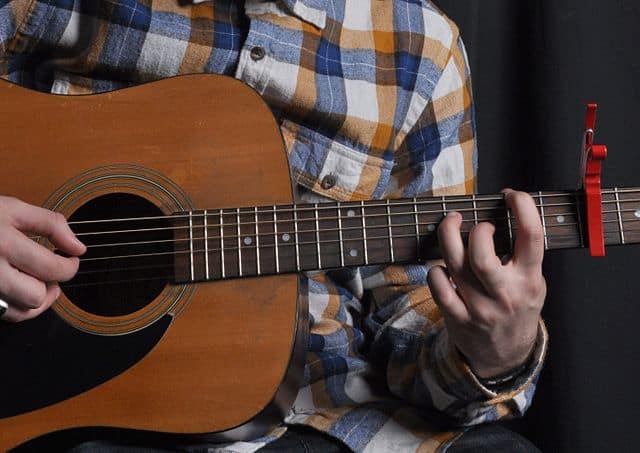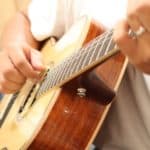Playing guitar with a capo is a rather straightforward experience.
You just put the capo where the chord chart says it goes and you just play.
But have you ever wondered why the capo goes there for that specific song?
And what would happen if you don’t use a capo for playing that?
Is there a way of playing capo songs without a capo?
Playing capo songs without a capo on guitar is completely doable, the only thing is that you will need to figure out what are the actual chords being played since the capo is a tool for transposing open chords. However, the sound you will get will not be the same because of different chord shapes.
In this article, I will tell you all there is about how songs that require a capo work on a musical theory level, and what are the alternatives if you don’t fancy using one.
After leaving this page, you will have a complete understanding of the function of a capo, and a clearer idea about how to transpose a piece of music into the key that suits you better.
Are you ready to get started?
Let’s go!
What’s the purpose of using a capo to play certain songs?
First of all, let’s agree on something: We hate barre chords, right?
Starting from there, I can tell you that using a capo is a way of avoiding them.
But how? You might be asking.
It’s simple, a capo just has the role of being a static barre at a certain point of your guitar’s neck.
The thing is, some players prefer the sound of chords a bit up the neck, and a capo allows you to play them without having to develop an extremely muscular index finger to keep up with the required barres.
Also, that static fretting allows you to play chord shapes that would be almost impossible if you were to also press down a barre.
Another great reason for using a capo is to just simplify playing in certain keys.
There are certain keys composed of chords that are not very comfortable to play with a guitar, especially because most of them require barring, and a capo just makes playing them way easier.
Finally, another great reason to use a capo on guitar is to just mindlessly transpose a certain song.
Moving the capo up or down and just playing the same chords will allow you to shift the tonality of a tune without even having to think about what chords you are actually playing.
You just focus on using the chord shapes you know and love.
Just to be extra clear with this last point: If you put the capo on the second fret of the guitar, and then play an open C chord, the notes you are actually playing are not those of a C chord, but the ones of a D chord, a tone higher.
Can songs that require a capo be played without it?
Yes, absolutely, chords are just chords.
Any song with a capo can be played without it, and any song without a capo can be played with one.
However, and although my last assertion is technically correct, for a song to sound exactly like the record, you will require to play the original chord positions that were recorded.
A capo is just a device for making playing them a more comfortable experience, and even a way of not having to think about what chords you are actually playing.
But if you don’t have a capo at hand, it’s just a matter of knowing what chord notes you are actually playing and finding a different place on the neck where they might work out.
The thing is, some groups of chords from certain keys are rather uncomfortable to play and might require you to work on your fretting hand stamina.
If you hate barre chords, you can do the opposite to find capo positions that allow you to play a certain song with as many open chord shapes as possible.
How to play capo songs without a capo?
If you want to play a song that’s commonly played with a capo without it, you will first have to figure out which are the actual chords you are playing.
As I mentioned earlier, chord shapes are just that: finger positions for playing major, minor, or any other kind of chord. When you move them around the neck you will end up playing a chord with its root on a different note than its open position.
The best way of figuring out which chords you are actually playing is by just looking at the lowest note being fretted.
For instance, following the example from the last section, if you have a C open chord shape, with a capo on the 2nd fret, the lowest tone you will be playing is a D (remember you don’t strum the sixth string on an open C chord shape).
Now, you also know that that particular shape gives you a major chord, so then you have a D major chord.
Easy, huh?
Now, say the next chord uses the shape of an open E minor chord.
What’s the lowest note being fretted, in this case by the capo? An F#. So, taking the chord type from the shape, you know you now have an F# minor chord.
And so on, and so on.
When you have all the chord names figured out, it will now be a matter of finding where to play them on the neck, but I’ll leave that to you since it is out of the scope of this article.
Do songs sound the same with or without a capo?
The only problem when transposing songs or figuring different positions to play them, if you consider it as an issue, is that things won’t sound the same.
You see, on the guitar, there are many places to play the same note across the strings, however, each of these positions sounds slightly different.
Multiply this now by all the notes on a certain chord and you will figure out that things might end up considerably different.
Think of playing an open C chord, and then a barre C chord on the third fret of the fifth string.
You can’t tell me they sound exactly the same.
It will still be technically and harmonically correct, though, but the sound might not be the one intended by the composer.
Why play a song with a capo if it can be played without it?
The most common use for a capo is to make songs easier on the fingers by allowing you to play them with simpler chord shapes.
However, some composers also use the capo higher on the fretboard to get a different sound from the instrument.
Try playing some of your favorite songs with the capo on the fifth fret or above, and you’ll see what I mean.
Finally, from a playability perspective, you might also feel that the higher you set up your capo, you will probably feel the action and tension of your guitar strings a bit more permissive.
This is particularly true for instruments set up with rather high action.

Hello there, my name is Ramiro and I’ve been playing guitar for almost 20 years. I’m obsessed with everything gear-related and I thought it might be worth sharing it. From guitars, pedals, amps, and synths to studio gear and production tips, I hope you find what I post here useful, and I’ll try my best to keep it entertaining also.





